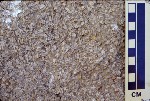Home | Session 3 | Sedimentary Rock Pg 1, 2, 3, 4, 5, 6, 7, 8, 9
What's in a Sedimentary Rock?
Presented
by Carol Tang
California Academy of Sciences
In the following set of slides, we are using fossils and their preservational state to interpret ancient landscapes and environments.
Very well-preserved fossils such as this articulated fish are fairly rare in the fossil record. That is because a fish and other organisms are often composed of lots of different pieces which fall apart quickly after death. In order for a fossil to be preserved in an articulated state, it had to have been buried fairly rapidly after death before burrowers, scavengers, storms, waves, etc. could break it up. So when we find something like this, not only is it good for biological information about the organism, but it can also tell us something about the environment in which it died. This is another example of these rare, well-preserved fossil deposits. In this case, instead of looking at a vertebrate organism, we are looking at invertebrate marine animals called crinoids, or sea lilies. These crinoids are made up of tiny skeletal pieces which are held together by soft tissue. Therefore, when the organism dies, usually the soft tissue decays and we are left with tiny disarticulated pieces. Only in rare situations like this can they be buried intact. These were buried in a basin with little oxygen--this helped prevent scavenging and decay by bacteria. This is what fossil crinoids which are not preserved intact can look like. Instead of being articulated, these crinoids have undergone some decay and therefore, their skeletal elements have started falling apart. You'll notice that these pieces are still found semi-intact. This is called a crinoidal limestone and it is jammed packed with broken pieces of crinoids. The condition of the fossils suggest that these were not buried immediately but still buried quickly enough to preserve some level of articulation. (Jurassic Carmel Formation, southern Utah)
updated February 11, 2002
UCMP Home | What's new | About UCMP | History of Life | Collections | Subway


